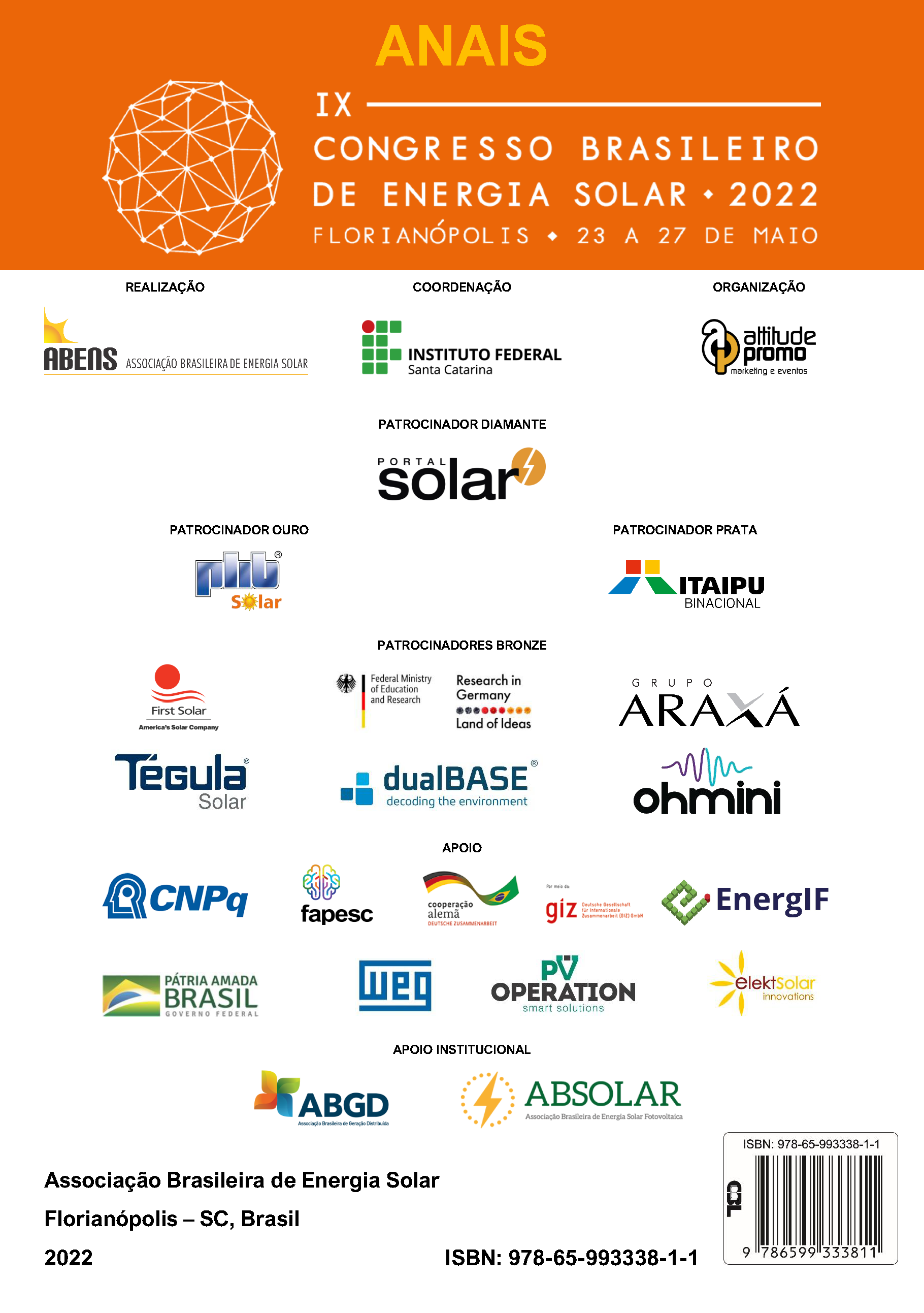MEAN HOURLY IRRADIANCE ESTIMATIVE BY THE SATELLITE GOES-16 IMAGES BASED ON TARPLEY’S 1979 MODEL
DOI:
https://doi.org/10.59627/cbens.2022.1172Keywords:
Estimative, GOES-16, Irradiance, TarpleyAbstract
The incident solar irradiance at the earth’s surface is the major environmental factor that has influence in the output power of a photovoltaic plant (SABINO, 2019). The solar irradiation estimative, or solar irradiance estimative by meteorological satellites has been presented as an alternative even for a pre-feasibility of photovoltaic plant projects, been used as input parameter in softwares that simulates the energy production of the plants and the capacity factor of a location, as for to be widely used as an input in forecast model works of solar resource. This paper has by objective make solar irradiance estimative from the visible channel images of the geostationary meteorological satellite GOES-16 using the model proposed by TARPLEY (1979). For this study, two locations in the state of Pernambuco (Recife e Petrolina) and one location close to Pernambuco in the state of Bahia (floating photovoltaic plant in the Sobradinho’s lake) were chosen. The hourly irradiance estimative for Petrolina showed an error nRMSE smaller than 15% and the other locations about 20%.
Downloads
References
Barros, H.; Costa, A.; Barbosa, E.; Vilela, O.C., 2017. Procedimento objetivo para a garantia de qualidade de dados de radiação solar. Avances en Energías Renovables y Medio Ambiente-AVERMA, 2017, v. 21, p. 67-78.
Cornejo-Buenoa, L.; Casanova-Mateob, C.; Sanz-Justoc, J.; Salcedo-Sanza, S., 2020. Machine Learning Regressors for Solar Radiation Estimation from Satellite Data. Solar Energy, v. 183, p. 768-775.
Gautier, C.; Diak, G.; Masse, S. A simple physical model to estimate incident solar radiation at the surface from GOES satellite data. Journal of Applied Meteorology. v. 19, n. 8, p. 1005-1012, 1980.
Iqbal, M., 1983. An Introduction to Solar Radiation. Academic Press, New York, 390 pp.
Losos, D., 2021. Beguinner’s Guide to GOES-R Series Data. v. 1.1.
NOAA, 2020. GOES-16 Transition: NOAA readies GOES-15 and GOES-14 for orbital storage. Ospo. Disponível em: < https://www.ospo.noaa.gov/Operations/GOES/16/transition.html>. Acesso em: 23 de novembro de 2021.
NOAA. Satellites. Weather. Disponível em: <https://www.weather.gov/about/satellites>. Acesso em: 02 de dezembro de 2021.
NOAA, NASA, DOC, NESDIS, 2020. Geostationary Operational Environmental Satellite (GOES) – R Series: ABI L2 Cloudy and Moisture Imagery Beta, Provisional and Full Validation Readiness, Implementation and Management Plan (RIMP). v. 2.0.
NOAA, NASA, GOES-R, S.P.O., GSFCG, 2019. GOES-R Series Data Book. Maryland, r. A.
Petribú, L. B.; Sabino, E.; Barros, H.; Costa, A.; Barbosa, E.; Vilela, O.C., 2017. Procedimento objetivo para a garantia de qualidade de dados de radiação solar. Avances en Energías Renovables y Medio Ambiente-AVERMA, 2017, v. 21, p. 67-78.
Sabino, E. R. C. Previsão de radiação solar e temperatura ambiente voltada para auxiliar a operação de usina fotovoltaicas. 2019. Tese (Doutorado em Tecnologias Energéticas e Nucleares) – Universidade Federal de Pernambuco, Recife, 2019. https://repositorio.ufpe.br/handle/123456789/36837
Salazar, G., Gueymard, C., Galdino, J., Vilela, O.C., 2020. Solar irradiance time series derived from high quality measurements, satellite models, and reanalyses at a near-equatorial site in Brazil. Renewable and Sustainable Energy Reviews, p. 117.
Satview. Tracking Satellites. Satview. Disponível em: < https://www.satview.org/index.php>. Acesso em: 02 de dezembro de 2021.
Tarpley, J.D., 1979. Estimating Incident Solar Radiation at the Surface from Geostationary Satellite Data. Journal of Applied Meteorology, v. 18, p. 1172-1181.


